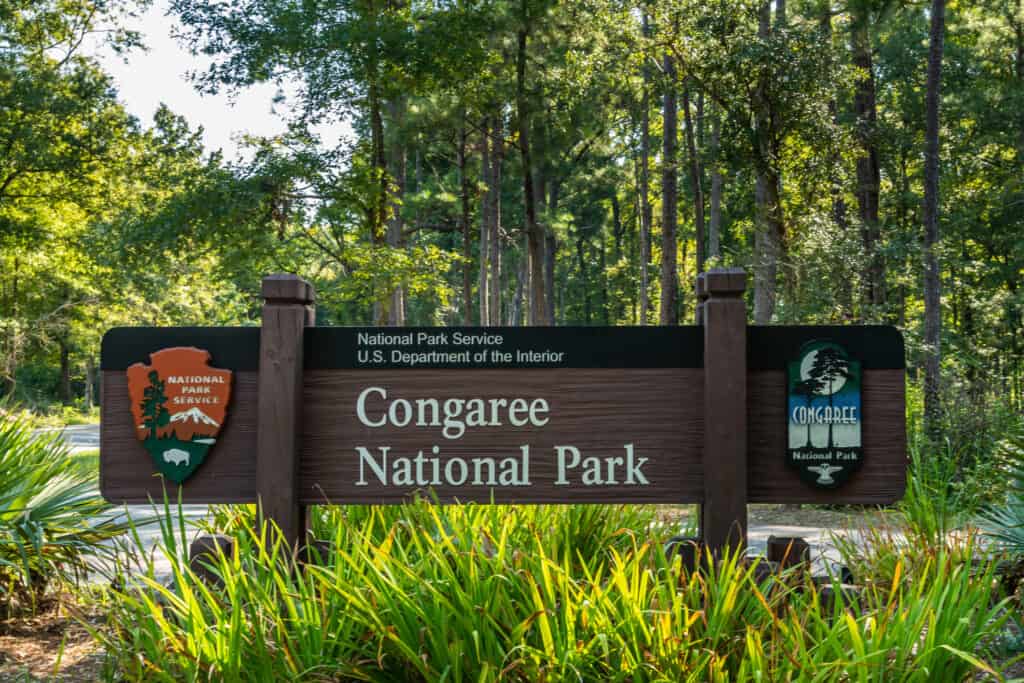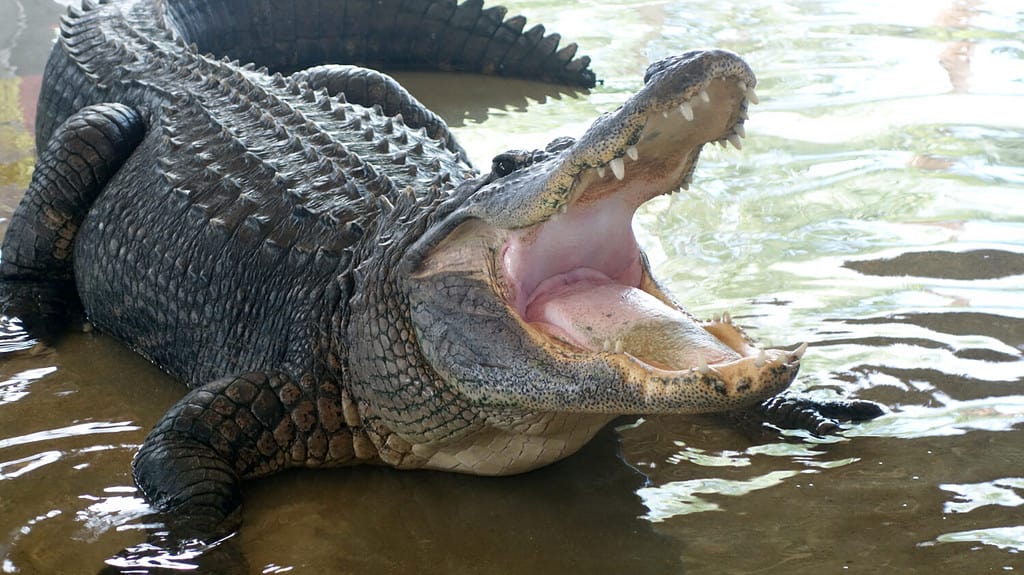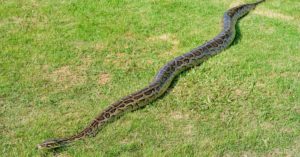Richland County lies in the geographic center of South Carolina. Its county seat, Columbia, is also the state capital. Richland is the second most populous county in the state, with over 416,000 residents. And it’s also home to some of the state’s estimated 100,000 alligators. So, if you live in Richland County or are planning to visit there, you might want to know if it’s safe to swim. Read on to find out!

Columbia, South Carolina is the state capital and the county seat of Richland County.
©Mihai_Andritoiu/Shutterstock.com
Meet the Alligator (or Not!)
Hopefully, you won’t ever meet an alligator, but let’s introduce some interesting facts about the species:
- These are large reptiles of the family Alligatoridae, which includes American alligators, Chinese alligators, and Caimans.
- The range of American alligators in the United States runs along the entire coast (and well-inland) of Texas all the way around to the North Carolina-Virginia border.
- On average, adults weigh 790 lbs. and can grow to 13 feet long, but large specimens can reach 990 lbs. and 14 feet in length.
- The longest-ever American Alligator was 19.2 feet long, and the heaviest-ever weighed 1,043 lbs.
- In captivity, alligators can live to over 80 years old.
- They live in shallow freshwater where they can float or walk along the bottom with only their eyes and nostrils showing.
- Although we usually associate alligators with swamps, they actually live in all sorts of fresh water, including golf course ponds, rivers, and even the occasional swimming pool.
- They also spend a good deal of time on land. As cold-blooded creatures, they warm themselves in the sun on riverbanks and islands. They also lay eggs in nests on land.
- Alligators are carnivores. Their diet includes mammals, fish, and amphibians. They can stalk and kill pets that are allowed to wander too close to their habitat.
- They kill larger prey by dragging it underwater to drown. In combat with larger prey, they will perform a “death roll” in the water to hold the animal or person under and to rip off bite-sized chunks.
- Alligators are usually timid toward people and try to run away if a human approaches. However, they are also territorial and defensive of their babies. They will attack people who get too close.

You should be aware of alligators when swimming in Richland County.
©iStock.com/Cindy Larson
Are there Alligators in Richland County?
Bodies of freshwater cover about 15 square miles of Richland County. However, the county is at the northern end of the range of alligators in South Carolina, as it gets too cool for them in the winter. The vast majority of the estimated alligator population of 100,000 live in the eastern, coastal part of the state. However, throughout their range, they have been slowly making their way inland. It’s not unusual to find them in and around Lake Marion in the south-central Midlands region. In Richland County, you’re most likely to encounter them in the wetlands of the Congaree River in the Congaree National Park. However, it’s also possible to spot a gator near Columbia while walking along the Broad and Congaree Rivers at the Riverfront Park and Canal in the heart of the city.
It also happens from time to time that an alligator is spotted outside the usual range of the species. Sometimes the reason for this is a person keeping a baby alligator as a pet and releasing it into the wild when it becomes too big and dangerous to handle. Thus, in any of Richland County’s natural or manmade freshwater sources, swimmers and hikers need to be alert and exercise caution.

Alligators in Richland County live mainly in and around Conagree National Park.
©iStock.com/kellyvandellen
Is It Safe to Swim in Richland County?
Alligators like to keep to themselves. They are shy reptiles that prefer to steer clear of human encounters. Sometimes unexpected close encounters happen, though. Alligators are especially aggressive and territorial during mating season and when protecting their young. The climate is warm enough in southern and coastal South Carolina that they are active year-round. No matter what the season, it is always best to avoid swimming in any body of water where people know there have been alligators in the past, even if you don’t see them.
The best alligator-free swimming in Richland County is at Lake Murray, a 50,000-acre reservoir northwest of Columbia. It is 41 miles long and 14 miles wide and has about 650 miles of shoreline, including sandy beaches. Lake Murray has all the hiking, camping, and watersports you could want, and best of all, there are no alligators. However, note that Lake Murray is on the northern edge of the current range of the species. Due to its popularity as a safe recreational area, no doubt the state will do its best to make sure alligators do not invade it. Visitors should stay alert and aware of their surroundings this close to alligator territory.

The blue, calm waters of Lake Murray, and its absence of alligators, makes it a popular spot.
©Carol Mellema/Shutterstock.com
Being Alligator-Safe in South Carolina
Here are a few tips to help keep you safe the next time you’re in or near the water in South Carolina:
- It is illegal to feed alligators in South Carolina. It puts you and others in danger, as it trains the animals to associate people with food and approach them when they’re hungry.
- You’re more likely to encounter alligators in shallow, marshy areas near the shore, but they do venture into deeper open water when hunting.
- Never swim alone. You need a buddy with you to help protect you and to call for help if needed.
- Be especially alert and vigilant with pets and children, as they are close in size to the animals’ natural prey and can be in danger.
- Whether in a boat or on land, if you see an alligator, turn around and go in the other direction. There is no need to zig-zag. Just get away quickly.
- Alligators can climb fences but cannot climb up trees or on top of vehicles. If you have a close encounter with an aggressive gator and can’t get away, get someplace high up.
- Do not swim in the mornings, evenings, or at night. Not only can you not see alligators well at those times, but that is also when they may be actively hunting nocturnal prey, versus the daytime when they frequently rest.

Be extra vigilant with pets and children to avoid alligator attacks when swimming in South Carolina.
©Nelosa/Shutterstock.com
Why Do Alligators Attack People?
Alligator attacks are actually pretty rare. South Carolina went many years without any attacks, but in 2022, five occurred in the same year, and tragically, two of those were fatalities. Sometimes attacks happen because people are unfamiliar with the area. So, for example, a tourist may think an area is safe for swimming when locals know that it is not. Unfortunately, some people also engage in thrill-seeking behavior. They might try to grab a selfie with a sleeping alligator but get grabbed in the process. Professionals on nature programs can make it seem fun and easy to grab a gator by the tail and avoid the sharp end, but a person who has no training can quickly find they made a bad mistake.
Historically, alligators have stayed in swampy areas along the coast that large numbers of people wouldn’t wander through. But with increased development, people are encroaching on their habitats, just as alligators also increase in number and encroach on human habitats further inland. Hunting alligators is legal in South Carolina, and this helps control the population. In recent years, hunters are reporting fewer and smaller kills so this may indicate that the population is not only stable but decreasing somewhat. Never fear though, conservation efforts mean this species is abundant throughout the South, numbering in the millions.

A resting alligator can look docile, but it is alert to its surroundings and can quickly lunge at threats.
©Leafyplant at the English Wikipedia, CC BY-SA 3.0 – License
Surviving an Alligator Attack
Anyone actually attacked by an alligator will surely have some nasty scars to help them tell the story the rest of their lives. But it is possible to survive an attack. Here are some tips:
- You want to stay on land if at all possible. The alligator is at an advantage in the water. Dig in your feet, hold on to something, and resist being dragged in that direction.
- Fight ferociously to make yourself scary, big, and unsafe prey for the alligator. Scream, jab its eyes, punch or kick it in the nose and throat.
- Try to make it gag by jabbing anything at hand deep into the back of the animal’s throat. So for example, if it has grabbed your arm, use the other hand to ram down its throat a stick, rock, water bottle, shoe, or anything else you can find.
- These defensive maneuvers may cause the alligator to temporarily release its jaws to get a better grip on its prey. That’s your moment to pull yourself free and escape.
- If the alligator tries to subdue you by going into a death roll, grab the animal with your free arm(s) and roll with it to minimize the injury they inflict.
- Seek medical treatment even if you have only small scratches. Any break in the skin could cause an infection.
- Always report even minor incidents to wildlife authorities. They need to keep track of areas where alligators are becoming a danger.

Alligators can inflict life-threatening injuries. Even a scratch from a baby alligator could cause infection.
©Ernie Hounshell/Shutterstock.com
Enjoy Your Vacation!
Yikes! After all this, how can you enjoy your next South Carolina vacation? Well, there’s always the hotel pool. But seriously, remember the millions of visitors who flock to this warm, beautiful, and gracious state every year, and how few attacks have occurred. Simply remain aware and observe these large reptiles from a very safe distance!
The photo featured at the top of this post is © Jim Schwabel/Shutterstock.com
Thank you for reading! Have some feedback for us? Contact the AZ Animals editorial team.






